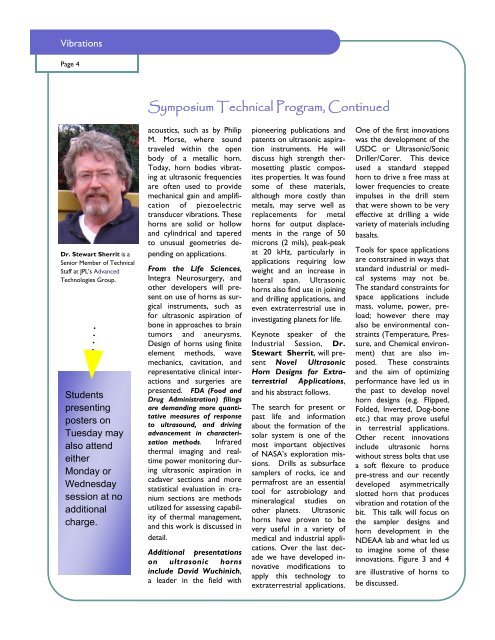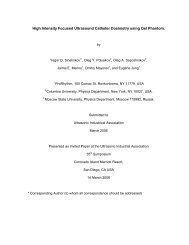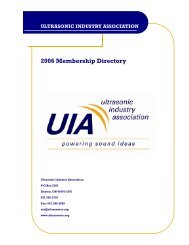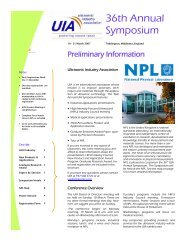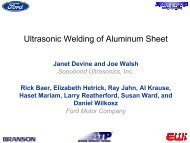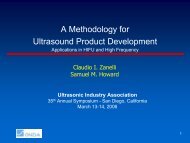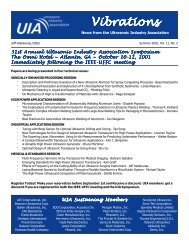2012 Spring issue of Vibrations (pdf) - Ultrasonic Industry Association
2012 Spring issue of Vibrations (pdf) - Ultrasonic Industry Association
2012 Spring issue of Vibrations (pdf) - Ultrasonic Industry Association
You also want an ePaper? Increase the reach of your titles
YUMPU automatically turns print PDFs into web optimized ePapers that Google loves.
<strong>Vibrations</strong><br />
Page 4<br />
Symposium Technical Program, Continued<br />
Dr. Stewart Sherrit is a<br />
Senior Member <strong>of</strong> Technical<br />
Staff at JPL's Advanced<br />
Technologies Group.<br />
Students<br />
presenting<br />
posters on<br />
Tuesday may<br />
also attend<br />
either<br />
Monday or<br />
Wednesday<br />
session at no<br />
additional<br />
charge.<br />
acoustics, such as by Philip<br />
M. Morse, where sound<br />
traveled within the open<br />
body <strong>of</strong> a metallic horn.<br />
Today, horn bodies vibrating<br />
at ultrasonic frequencies<br />
are <strong>of</strong>ten used to provide<br />
mechanical gain and amplification<br />
<strong>of</strong> piezoelectric<br />
transducer vibrations. These<br />
horns are solid or hollow<br />
and cylindrical and tapered<br />
to unusual geometries depending<br />
on applications.<br />
From the Life Sciences,<br />
Integra Neurosurgery, and<br />
other developers will present<br />
on use <strong>of</strong> horns as surgical<br />
instruments, such as<br />
for ultrasonic aspiration <strong>of</strong><br />
bone in approaches to brain<br />
tumors and aneurysms.<br />
Design <strong>of</strong> horns using finite<br />
element methods, wave<br />
mechanics, cavitation, and<br />
representative clinical interactions<br />
and surgeries are<br />
presented. FDA (Food and<br />
Drug Administration) filings<br />
are demanding more quantitative<br />
measures <strong>of</strong> response<br />
to ultrasound, and driving<br />
advancement in characterization<br />
methods. Infrared<br />
thermal imaging and realtime<br />
power monitoring during<br />
ultrasonic aspiration in<br />
cadaver sections and more<br />
statistical evaluation in cranium<br />
sections are methods<br />
utilized for assessing capability<br />
<strong>of</strong> thermal management,<br />
and this work is discussed in<br />
detail.<br />
Additional presentations<br />
on ultrasonic horns<br />
include David Wuchinich,<br />
a leader in the field with<br />
pioneering publications and<br />
patents on ultrasonic aspiration<br />
instruments. He will<br />
discuss high strength thermosetting<br />
plastic composites<br />
properties. It was found<br />
some <strong>of</strong> these materials,<br />
although more costly than<br />
metals, may serve well as<br />
replacements for metal<br />
horns for output displacements<br />
in the range <strong>of</strong> 50<br />
microns (2 mils), peak-peak<br />
at 20 kHz, particularly in<br />
applications requiring low<br />
weight and an increase in<br />
lateral span. <strong>Ultrasonic</strong><br />
horns also find use in joining<br />
and drilling applications, and<br />
even extraterrestrial use in<br />
investigating planets for life.<br />
Keynote speaker <strong>of</strong> the<br />
Industrial Session, Dr.<br />
Stewart Sherrit, will present<br />
Novel <strong>Ultrasonic</strong><br />
Horn Designs for Extraterrestrial<br />
Applications,<br />
and his abstract follows.<br />
The search for present or<br />
past life and information<br />
about the formation <strong>of</strong> the<br />
solar system is one <strong>of</strong> the<br />
most important objectives<br />
<strong>of</strong> NASA’s exploration missions.<br />
Drills as subsurface<br />
samplers <strong>of</strong> rocks, ice and<br />
permafrost are an essential<br />
tool for astrobiology and<br />
mineralogical studies on<br />
other planets. <strong>Ultrasonic</strong><br />
horns have proven to be<br />
very useful in a variety <strong>of</strong><br />
medical and industrial applications.<br />
Over the last decade<br />
we have developed innovative<br />
modifications to<br />
apply this technology to<br />
extraterrestrial applications.<br />
One <strong>of</strong> the first innovations<br />
was the development <strong>of</strong> the<br />
USDC or <strong>Ultrasonic</strong>/Sonic<br />
Driller/Corer. This device<br />
used a standard stepped<br />
horn to drive a free mass at<br />
lower frequencies to create<br />
impulses in the drill stem<br />
that were shown to be very<br />
effective at drilling a wide<br />
variety <strong>of</strong> materials including<br />
basalts.<br />
Tools for space applications<br />
are constrained in ways that<br />
standard industrial or medical<br />
systems may not be.<br />
The standard constraints for<br />
space applications include<br />
mass, volume, power, preload;<br />
however there may<br />
also be environmental constraints<br />
(Temperature, Pressure,<br />
and Chemical environment)<br />
that are also imposed.<br />
These constraints<br />
and the aim <strong>of</strong> optimizing<br />
performance have led us in<br />
the past to develop novel<br />
horn designs (e.g. Flipped,<br />
Folded, Inverted, Dog-bone<br />
etc.) that may prove useful<br />
in terrestrial applications.<br />
Other recent innovations<br />
include ultrasonic horns<br />
without stress bolts that use<br />
a s<strong>of</strong>t flexure to produce<br />
pre-stress and our recently<br />
developed asymmetrically<br />
slotted horn that produces<br />
vibration and rotation <strong>of</strong> the<br />
bit. This talk will focus on<br />
the sampler designs and<br />
horn development in the<br />
NDEAA lab and what led us<br />
to imagine some <strong>of</strong> these<br />
innovations. Figure 3 and 4<br />
are illustrative <strong>of</strong> horns to<br />
be discussed.


